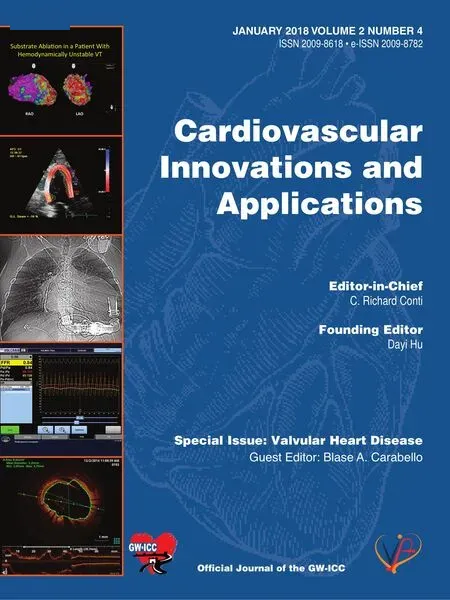Decision Making in the Cardiovascular Patient
C. Richard Conti, MD, MACC
Introduction
Clinical decision-making is what all cardiovascular physicians do. The purpose of decision-making is to make the diagnosis, decide on appropriate therapy and estimate the prognosis of the individual patient.Regarding the prognosis, population prognostic data is used but this may or may not apply to the individual patient. LV function, no matter how it is determined seems to correlate best with prognosis.But we need to remember that prognostication of the individual is, at best, an educated guess.
What is Necessary for Cardiovascular Decision Making
It is clear to physicians who see patients with cardiac disease that every patient requires, in addition to the present illness, physical exam, past, social and family history as part of the evaluation. As a cardiologist, I use the complete history, physical exam,ECG and chest X-ray for the cardiovascular work up. Laboratory tests such as serum troponin levels,cardiac ultra sound and other imaging modalities are commonly used as well.
Cardiovascular Physical Exam
It is important to remember that the physical examinat ion of the CV system is not only auscultation but also involves other parameters such as blood pressure, heart rate and rhythm, peripheral pulses,pulmonary evaluation, level of consciousness and stability of the patient.
Imaging as a Major Part of Decision Making
What follows is a list of the usefulness of modern imaging when assessing the individual patient.
1. ECG – This laboratory test can measure heart rate, arrhythmias, bundle branch block quite accurately and is compatible with diagnoses such as LVH, presence or absence of ischemia, pericarditis, coronary occlusion and certain congenital heart diseases e.g. Atrial septal defect.
2. Chest X-ray allows the assessment of cardiomegaly (if standard PA and lateral views are used) pleural effusions, pneumonitis, pulmonary venous congestion (usually due to pulmonary edema), and increased pulmonary blood flow,often related to left to right shunts.
3. Serum troponin levels are important in making the diagnosis of myocardial infarction and are compatible with the diagnosis of pericarditis (epimyocarditis) and myocarditis. Troponins may be elevated for reasons other than cardiac,e.g. chronic kidney disease, and have less (but not zero) clinical signi ficance for ischemic heart disease or other cardiac causes.
4. Chest CT-will amplify and enhance what is seen on the plain chest X-ray, quanti fication of coronary artery calci fication and with contrast angiography, will allow the diagnosis of pulmonary embolism, coronary artery disease, aortic disease, cardiac masses, e.g. (pleural effusion and other lung disease.)
5. Cardiac magnetic resonance allows the assessment of LV function, valve stenosis and insuf fi-ciency, aortic dissection, in filtrative disease of the myocardium, myocardial ischemia, myocardial infarction, thrombus or tumors in the atria or ventricle and most congenital heart disease.
6. Cardiac ultrasound allows the assessment of LV function, valve stenosis and insuf ficiency, presence or absence of clots or tumors in the ventricle and atria, presence of absence of pulmonary hypertension and some congenital heart disease.
7. Right heart catheterization allows the assessment of right atrial pressure (for volume overload) pulmonary artery pressures and pulmonary capillary wedge pressure.
8. Left heart catheterization/coronary angiography and ventriculography allows the assessment of presence, location and severity of coronary artery disease, LV/aortic pressure (aortic valve stenosis)aortic angiography (aortic insuf ficiency and aortic disease) and LV angiography for left ventricular function, and LV diastolic pressure.
What is Best for Various Cardiovascular Diseases
As a general rule a history and physical is best for heart failure, ECG is best for arrhythmias and ischemia (especially exercise treadmil) and/or infarction and coronary angiography and nuclear or dobutamine stress testing for coronary artery disease detection. It is important to understand and be aware that all laboratory tests have false positive and false negative results. The classic cardiovascular one is nuclear perfusion.
Accountability of Complexity of Diagnosis
In the era of the electronic medical records in 2017,physicians are now expected to be accountable for recording the complexity of the patient being evaluated. They must develop points that determine complexity. This is true for inpatient and outpatient evaluation. For example, for new in patient consult evaluation, level 5 (high complex) HPI requires four descriptors, ROS requires ten system reviews,PH requires one, FH requires one and Social history requires one. Physical examination requires eight organ system descriptions.
As far as I can tell, except for imaging (including the ECG) not much else is required to evaluate blood tests.
Medical decision making involves, Risk,Problems and amount of information reviewed,interpreted, and discussion with family.
Judgement is Still Needed
Overall, physicians still need to use judgement when making clinical decisions. It seems to me that judgment is more commonly used by the older, experienced, senior physician compared to the young physician just out of training with little experience and whose focus is on the literature and guidelines. Judgement is based on experience and knowledge of the literature. There should be no question in anyone’s mind that, all things considered, the longer one practices medicine, the more experience one gains. The cardiologist just out of training, making clinical decisions, is generally not as quali fied as a senior colleague making similar decisions.
Decision making in many instances requires a combination of history and physical examination,viewing of images and other laboratory tests and often, in difficult cases, passage of time.
 Cardiovascular Innovations and Applications2018年1期
Cardiovascular Innovations and Applications2018年1期
- Cardiovascular Innovations and Applications的其它文章
- Mitral Stenosis: A Review
- Functional Tricuspid Regurgitation and Ring Annuloplasty Repair
- Misdiagnosed Aortic Intramural Hematoma and the Role of Intravascular Ultrasound Imaging in Detection of Acute Aortic Syndrome: A Case Report
- Management of Mitral Regurgitation in a Patient Contemplating Pregnancy
- An Asymptomatic Patient with Severe Mitral Regurgitation
- Clinical Evaluation of a Patient with Asymptomatic Severe Aortic Stenosis
